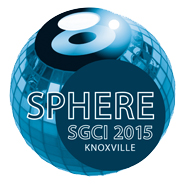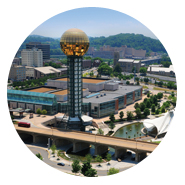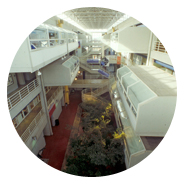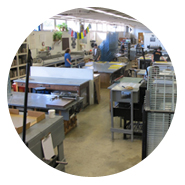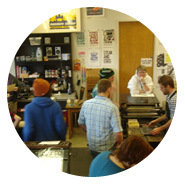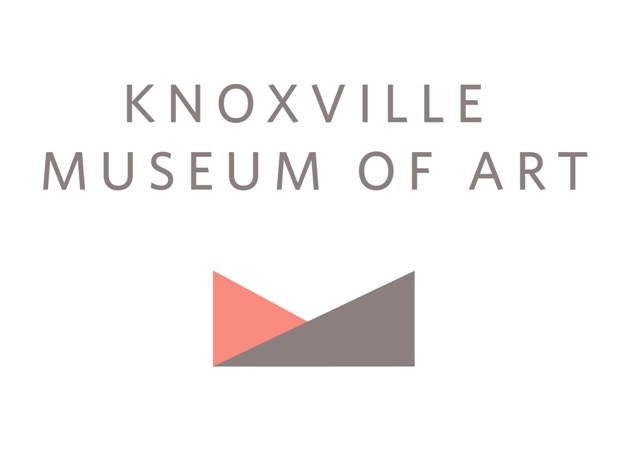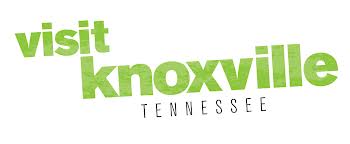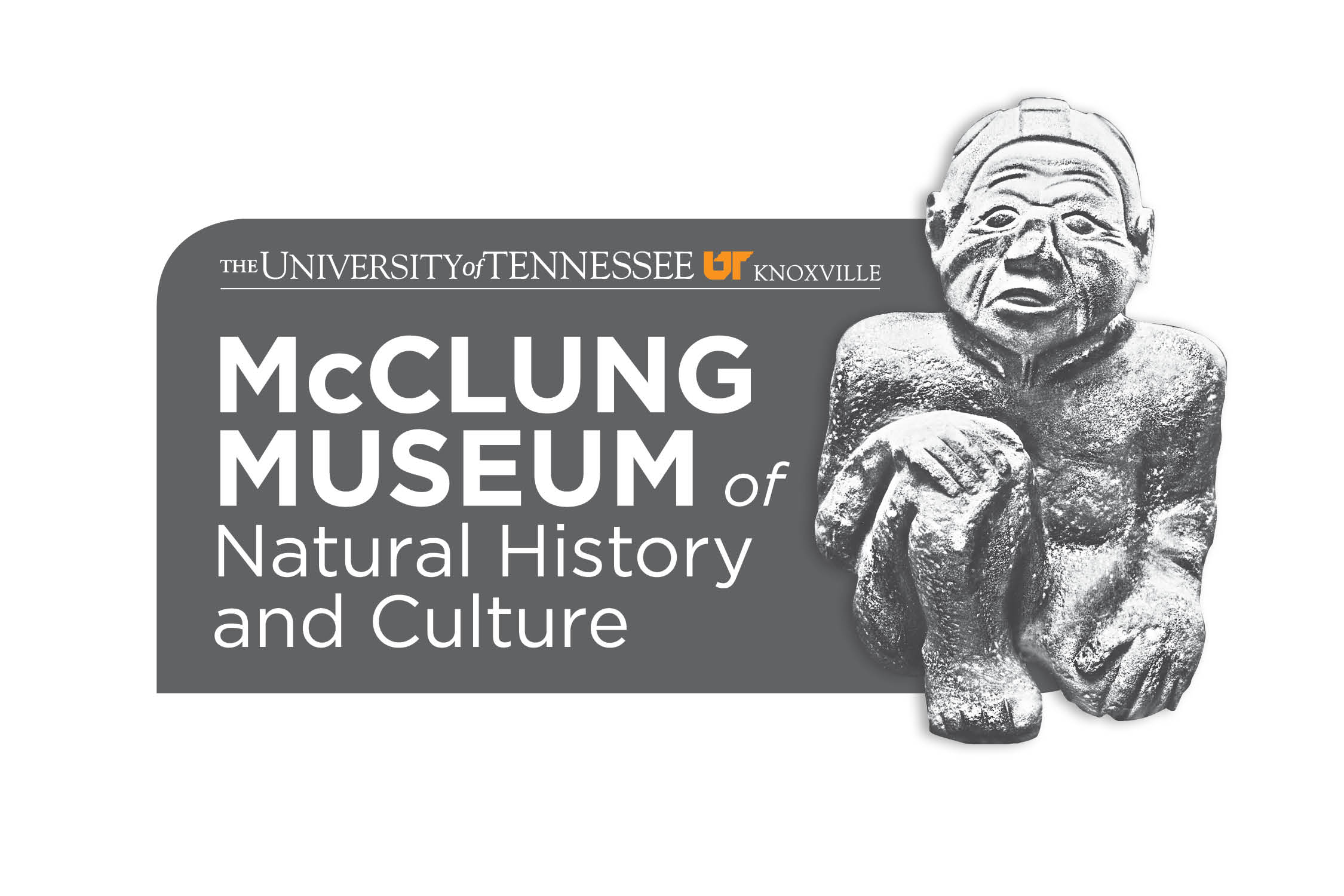TECHNICAL DEMOS
Technical demos will cover both traditional and non-tradiitional methods. Most demos will take place in the School of Art of the University of Tennessee, Knoxville on Friday March 20th and Saturday March 21st. We are also making arrangements to present demos at the Product-Publisher's-Program Fair on Thursday March 19th. In some cases, demos have been scheduled into multiple time slots, or involve projects over a longer interval. Technical hand outs will be posted later. Questions? Please contact Koichi Yamamoto: kyamamo2@utk.edu
-
Thursday 3/19
-
Friday 3/20
-
Saturday 3/21
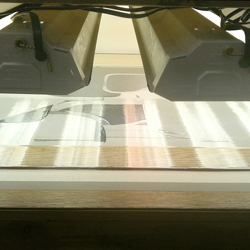
Building an Inexpensive Vacuum Exposure Unit
Bud Shark, Sharks INK
[A1] Thursday March 19, 10:00-11:30am, Product-Publisher’s-Program Fair, KCC, Exhibit Hall B
DOWNLOAD DEMO HANDOUT
Since 1976 I have used a “homemade” exposure unit for thousands photo plates created in my studio. When I started Shark’s Lithography I wasn’t able to afford a manufactured commercial exposure unit and improvised a simple and crude unit. Since then I have continued to use a “homemade” unit based on that first one for exposing all photo plates. The demonstration will show how to build a portable and inexpensive vacuum exposure unit using commonly sourced materials. The exposure unit may be used for photo positive and negative litho plates, solar plates and other photo-based processes. The unit can be easily customized for plates of any size. A complete materials list, diagram and instruction sheet will be provided.
______________________________________________________________________
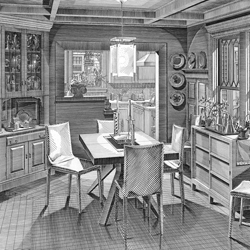
Engraving Images
Andrew Raftery, RISD, Providence, RI
[B1] Thursday March 19, 12:00-1:30pm, Product-Publisher’s-Program Fair, KCC, Exhibit Hall B
This demonstration will present some basic principles of engraving on copper. I will show plates at various stages of working, and will produce a finished print. Press provided by Tackach Press Company.
______________________________________________________________________
Paper Plate Lithography: Cheap, Fast and Easy
Heather Muise, East Carolina University
[C1] Thursday March 19, 1:45-3:15pm, Product-Publisher-Program Fair, KCC Exhibit Hall B
DOWNLOAD DEMO HANDOUT
Using photocopies or laser prints as a matrix is a cheap, fast and effective means of printing images lithographically with out the need for litho stones, aluminum plates, solvents, acid or even a press. This method is excellent for creating lush and layered monoprints, as well as a quick way to transfer images to canvas, wood, or even etching plates. What’s more, images can be printed on a variety of surfaces, including three-dimensional objects. This demonstration will show how to create images work best with the process, how to process the paper plates, inking techniques and printing images on two and three-dimensional surfaces.
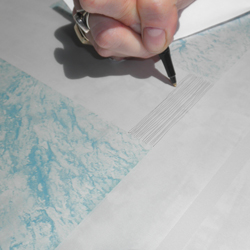
Photo Litho Plates: Not Just for Photo Anymore
Carolyn M. Muskat and Kate Goyette, Muskat Studios
[E1-F1] Friday March 20, 10:00-11:30am and 12:00-1:30pm, Printshop, AA241 West
DOWNLOAD DEMO HANDOUT
Photo processes have been a part of printmaking for over 100 years. From commercial reproduction applications to hand-drawn graphics, photographic elements are an integral part of print media. For artists, these wide-ranging uses provide an expanding array of expressive possibilities, either in stand-alone photo-based imagery or in combination with hand-drawn elements. Emerald Green photo litho plates can offer a very tight structure that produces images with remarkable tonal transitions – all without the use of traditional half-tone dots. Artists can use a range of films to create images, including inkjet, laser, copier, and hand-drawn films. It is through the treatment of the Emerald Green photo litho plates as a hybrid of traditional aluminum plates and polyester plates, that any lithographer and printmaker can dependably create, stabilize, and print from photo litho plates. This demonstration will focus on successfully preparing, exposing, processing, and printing Emerald Green photo litho plates while also introducing methods for artists to draw directly onto the plate both before and after printing the photo image.
______________________________________________________________________
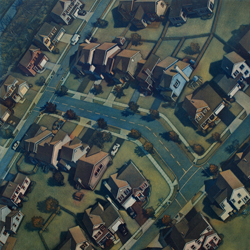
One + One = Infinity
Art Werger, Ohio University
[E2-F2] Friday March 20, 10-11:30am and 12:00-1:30pm, Printshop, AA 241 East
DOWNLOAD DEMO HANDOUT
In an attempt to demystify the process of full color intaglio printing, Art Werger will use a la poupee inking to create a full palette image from two copper plates. Werger will explain how he develops an image on two plates using a warm/cool approach and a novel approach to color theory (any given color is achieved through the balance of two complementary colors). Examples will show how the plates are drawn as stage-bitten aquatints using lithography crayons over rosin aquatint. He will also explain a time-saving proofing method, the Color Grid Print, that provides a variety of possible color solutions. Finally, he will demonstrate how to use a stencil and relief roll to heighten and intensify the intaglio color range.
______________________________________________________________________
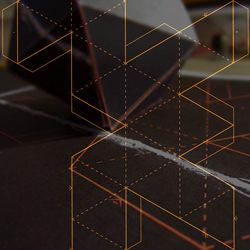
3-Ring Circuits, Creating Interactive Sculptures with Paper Circuits
Erik Waterkotte, University of North Carolina, Charlotte
Heather Freeman, University of North Carolina, Charlotte
Ryan Buyssens, University of Central Florida, Orlando
[E3-F3] Friday March 20, 10-11:30am and 12:00-1:30pm, Printshop, AA 241C
3-Ring Circuits is an interdisciplinary, technical demonstration creating paper circuit sculptures via the integration of basic 3-D digital modeling, silkscreen printmaking, and circuit design. 3-Ring Circuits includes 3 artists from 3 different disciplines, integrating 3 processes in 3 stages. All with an installation finale.
Stage 1, artist Heather Freeman will demonstrate how to create basic, 3-D graphics (polyhedrons like the pictured, icosphere) that can be outputted from 3 dimensions into unfolded, 2 dimensional forms, via the use of open-sourced, software like Blender.
Stage 2, artist Erik Waterkotte will create multiple paper circuits by printing the unfolded/flattened design with photo-silkscreen using water-based, conductive ink. Erik will print an edition of this paper circuit to give to the demo audience for participation in the third and final stage.
Stage 3, artist Ryan Buyssens will use the printed, paper circuits to create illuminated paper sculptures that are self-contained using common 9V batteries and LED’s. With time allowing Ryan Buyssens will also discuss/display the use of Arduino circuit kits and small motors with the paper circuit sculptures. Keeping in mind time limitations, 3-Ring Circuits is designed to detail the methods described by producing simple, interactive paper circuits.
Finale, visitors will assemble printed paper sculptures and LED’s for an illuminated, outdoor installation along the Prints in Peculiar Places Printstallations.
______________________________________________________________________
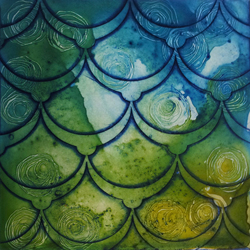
The Sphere of Vinyl/Media Cutting for Aid in Platemaking
Margaret Craig, Southwest School of Art, San Antonio, TX
Dinah Coakley, San Antonio, TX
[E4] Friday March 20, 10:00-11:30am, AA East Atrium
DOWNLOAD DEMO HANDOUT
This demonstration will show how to use computerized cutting to augment intaglio, screen-printing, relief, monoprints and dry point. First the demonstration will show transferring an artist’s own images or text from PC or MAC into the vinyl cutter software, and how to make the cut outline. Feeding materials and adhering cut designs to the matrix will be shown. Cut vinyl designs can be used for acid resist, low relief, and silkscreen stencils. Cut sand blast mask, stuck to any matrix makes a low relief plate that can be additionally cut with relief tools. Load Lexan, Yupo or thin plastic into the cutter and the cutting blade will drypoint the material. An inexpensive media cutter can aid almost any printmaking process.
______________________________________________________________________
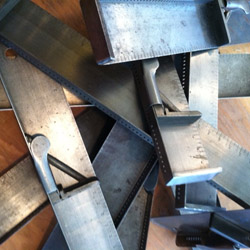
Easy Magic, Simple Tricks, and Priceless Tips - For the Letterpress Studio
Bryan Baker, Striped Light // Hands-On-Press, Knoxville, TN
[E5-F5] Friday March 20, 10:00-11:30 and 12:00-1:30pm, Letterpress Studio, AA345A
Exciting trade secrets, daring innovations, and clever techniques get revealed! 25 lightning fast demonstrations shown back to back! Become more efficient, more proficient, and super smooth in your shop. Whether you have been working around letterpress for 1 year or 50 of them, you are guaranteed to see a few exciting things. There will be doses of insight ranging from 10 second explanations up to 5 minute long reenactments of scientific breakthroughs. Sneaky truths will be told about: shop organization, fancy typesetting, ink-mixing, registration, stable lock-ups, polymer CPR, cylinder presses, and tabletop platen predicaments
______________________________________________________________________
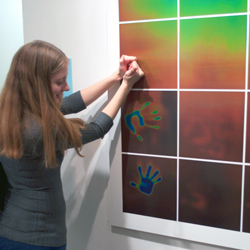
INK Version 2.0: The Creative Potential Of Advanced Ink Technologies
Brian Gonzales, illegitimate press, Supergraphic Center for Print Research and Production
[F4] Friday March 20, 12:00-1:30pm, AA East Atrium
I will be discussing and demonstrating thermochromic, photochromic, hydrochromic, liquid crystal, and conductive inks. Thermochromic and liquid crystal inks change color based on temperature. Photochromic ink changes color with exposure to sunlight. Hydrochromic ink changes color with exposure to moisture and conductive inks will carry an electric charge. I will be demonstrating these inks using screenprinting and relief printing processes in addition to discussing possible fine art applications.
______________________________________________________________________
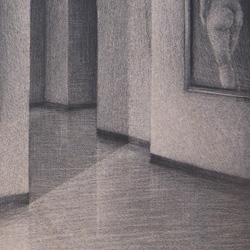
Prints from the Unrocked Rock: the Curious Art of Mezzo-Litho
Donald Furst, University of North Carolina, Wilmington
[G1] Friday March 20, 1:45-3:15pm, Printshop, AA241 West
DOWNLOAD DEMO HANDOUT
Velvety blacks and subtle tonal gradations are prized in the intaglio mezzotint process. But the method requires a prolonged, painstaking preparation of the metal before the actual image making can proceed. In the early 1800s, experiments in the infancy of lithography sought mezzotint-like effects from Bavarian limestone. Over time, many of the processes attempted have disappeared into obscurity. As a long-time mezzotint artist and stone lithography devotee, I became curious about how one might import the particulars of one printmaking realm into another. The result is what I call “Mezzo-Litho.” My demonstration will present the optimum way to establish a suitable black flat, the best tools for mezzotint-like subtractive work, some caveats on appropriate etching, and thoughts on best printing practice to achieve the richest images.
______________________________________________________________________
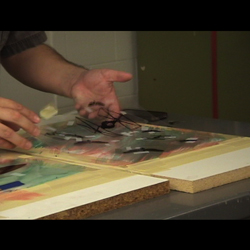
Diazo Monoprints
Stacy Elko and Manuel Gonzales, Texas Tech University
[G2] Friday March 20, 1:45-3:15pm, Printshop, AA241 East
DOWNLOAD DEMO HANDOUT
We will present a low tech but innovative technique that can be used by itself, or with other printmaking techniques, digital transfers, or even other art techniques. We will be showing a non-press, photographic screenprinting emulsion technique. Papers are coated with screenprinting emulsion and watercolor pigments. Images are contact exposed with flood lights and the unexposed emulsion is then washed out and dried. The pieces can then be recoated with other colors and re-exposed created a multilayered technique. This technique is done on paper but can also be done on primed wood, metal, ceramic and fabric. They will appeal to both print and photo artists who do not have access to a traditional studio. It will also be of interest to artists who are interested in exploring alternative techniques that explore printmaking, photography, and painting. And as the techniques are non-toxic and relatively simple, art educators working with children can avail themselves of these techniques with any age group. The examples below are examples of the technique. This demo is designed with audience participation in mind.
______________________________________________________________________
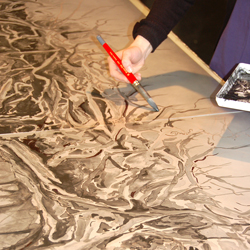
Litho-Sphere 2015: A Collaboration
Dwight Pogue and Barry Moser, Smith College
[G3-H3] Friday March 20, 1:45-3:15pm and 3:30-5:00pm, Printshop, AA 241C
For this demonstration, renowned artist-illustrator Barry Moser creates his first full-color lithograph in collaboration with author and artist-printmaker Dwight Pogue, and emerging artist-printmakers Lauren Bennett, Kate Conlon, and Andrew Maurer. They are joined in this group project by printing plate engineer, Skip Klepacki. Moser will create a full-color, low cost lithograph using a hand-drawn CMYK technique. Moser will combine traditional drawing materials with toner washes and sharpie paint pens on the reusable Century Plate. Pogue and his team will demonstrate a system for printing Moser’s high quality lithograph on a standard etching press. The team will share techniques for exposing drawings/paintings on mylar to studio sensitized Century Plates as well as high resolution printing on Plike, an archival synthetic paper from a 400 year old Italian paper mill. The artist and printers will process the plates using only bio-based and biodegradable solvents and materials. Sustainable multi-color lithography comes ‘Full-Circle’ using new techniques and safer materials easily combined with traditional printmaking processes in the classroom or studio.
______________________________________________________________________
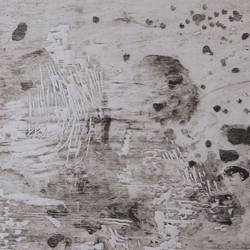
All for One and One for All: Wood Lithography and the Unification of Process
Adrienne Lichliter
[G4] Friday March 20, 1:45-3:15pm, AA East Atrium
DOWNLOAD DEMO HANDOUT
For the last two years I have been heavily invested in the process of wood lithography, originally drawn to it for its similarity to plate tone and incorporation of wood grain. This relatively unknown practice not only is considerably more accessible than stone lithography, but also offers an entirely different aesthetic. Grains, plate tones and carving work together with lithographic marks creating a visual marriage between intaglio, relief and lithography that is unlike any of the singular processes. My demo will show the basics of wood lithography, demonstrating different possible mark making methods (crayon, tusche and oil based sharpie), the etching process, and the particular rolling techniques. I will also demonstrate the use of relief in conjunction with the lithography as well as viscosity printing, allowing for multiple techniques and colors in a single run.
______________________________________________________________________
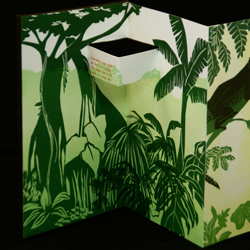
Letterpress Printing with Flexi-cut
Sarah Noreen Hurtt
Corcoran College of Art and Design
[G5-H5] Friday March 20, 1:45-3:15pm and 3:30-5:00pm, Letterpress Studio, AA335A
DOWNLOAD DEMO HANDOUT
An adhesive-backed, flexible material, Flexi-Cut cuts easily with scissors and linoleum cutters to
produce clean, crisp prints while also being budget friendly. Using Flexi-Cut mounted on woodmounted linoleum blocks, I will demonstrate how one can achieve interesting flats, silhouettes, and detailed, lino-cut like imagery in your letterpress printing. It is an excellent material to use for small editions as it is inexpensive and does not require as much time to produce an image. By mounting Flexi-Cut pieces on mounted linoleum, one can change images/pieces without removing the block, making registration easier and quicker. Mounted linoleum is also not type high, but adding a layer of Flexi-Cut will produce a type-high block with little to no shimming. Below is a book that I made using Flexi-Cut. Printed in an edition of 10 on a Vandercook SP15 – all images were carved using Flexi-Cut and then mounted on wood-backed linoleum.
______________________________________________________________________
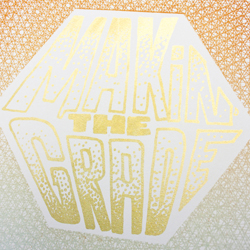
I Wanna Flock (from Rocks)!
Tate Foley, Webster University
[H1] Friday March 20, 3:30-5:00pm, Printshop, AA241 West
DOWNLOAD DEMO HANDOUT
Using multiple, fine powdered pigments, lithography can be an excellent base with which to flock – creating multiple color prints using only transparent base. I Wanna Flock will demonstrate mixing modifiers into the transparent base, printing the image, using soft-bristle brushes to work powdered pigments into the image, and finishing techniques post-drying. The major benefit of this technique is the ability to use iridescent pigments, which not only create a vivid color palette and visually stimulating image, but also are more cost effective than iridescent inks (gold, silver, etc.)
______________________________________________________________________
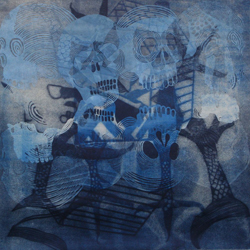
Diffused Relief Printing Using an Etching Press
Monika Meler, University of the Pacific
[H2] Friday March 20, 3:30-5:00pm, Printshop, AA241 East
This demonstration will focus on Diffused Relief Printmaking, a hybrid process that brings together relief, collagraph, and monotype. The demonstration will focus on using uneven pressure to produce beautiful, spontaneous, and multi-layered prints. This process, using matrices carved out of mat board produces soft, diffused images that are very different from the graphic marks that printmaking is often known for. Multi-layered printing and registration will also be covered in the demonstration. Participants will discover a range of possibilities while learning how to approach printmaking from a fresh, new perspective to compose layered, rich prints. Prints created using this technique require no chemical processes, which means that the heavy chemistry often associated with printmaking is eliminated. All matrices are mat board, so they can be recycled once the prints are finished.
______________________________________________________________________
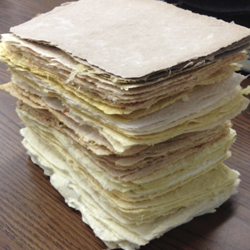
Another Sphere: Alternative Papermaking
Amanda Berry, Kendall College of Art and Design
[H4] Friday March 20, 3:30-5:00, East AA Atrium
DOWNLOAD DEMO HANDOUT
Often papermaking and printmaking go hand in hand and for many artists they occupy the same sphere. This interactive demonstration will explore various ways in which food can be used to create various colors and textures in papermaking. Papermaking techniques will involve curry, cinnamon, cocoa powder, carrot, and tomato soup. Conference participants will be able make-a-paper and take-a-paper.
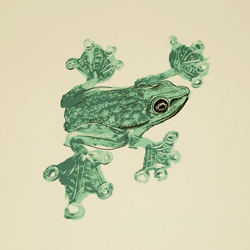
Acetate Kissing
Aaron Artrip, Independent Artist, Atlanta, GA
[I1] Saturday March 21, 10:00-11:30, Printshop, AA241 West
DOWNLOAD DEMO HANDOUT
Acetate Kissing is a form of topographical screenprinting, and embodies many of the same principles as topographical maps. I create a line drawing as a template underneath a sheet of acetate, for reference. Using medium to heavy bodied black acrylic paint, I paint onto the acetate in a fast, sketching style that harnesses the beauty of the immediate brush stroke. Once I have finished painting, I then take additional sheets of acetate and gently press together, or “kiss,” the surface of the textured, all black painting. The “kissing” action helps to separate the different elevations of paint onto the different acetate layers. After the acetates are dry, I scan them into Photoshop as a tool to explore color palettes and options. The acetates are then exposed and combined with split fountain print techniques to maximize the number of colors present in the final prints. The resulting images create a spontaneous mark making that is tedious to replicate with traditional techniques.
______________________________________________________________________
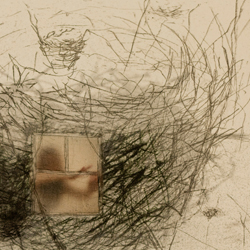
Combining Digital and Traditional Output in Prints
Kelsey Stephenson, University of Tennessee
[I2] Saturday March 21, 10:00-11:30am, Printshop, AA 241 East
DOWNLOAD DEMO HANDOUT
This demo is focused on how to combine printed digital output with more traditional printmaking techniques, which allows the introduction of additional layering to a print. The method used is quite versatile and can be applied to relief printmaking, lithography or other mixed media images, although for the purposes of the demo intaglio methods will be used to demonstrate. After creating a key plate (using copper and /or collagraph as the specific demo examples) participants will learn how to create digital registration files for the image from the plate, and how to then add additional layers of information on the computer using Adobe Photoshop. These digital layers can be photographic images, pure color or photo montage layers, and can be on only a small part of the image or cover the entire printed area. Once this is demonstrated, participants will also learn how to print off the digital image from the computer on an Epson inkjet so it can be combined with the plate, and how to print the digital output with the plate for a completed print that includes both the traditional print with digital techniques.
______________________________________________________________________
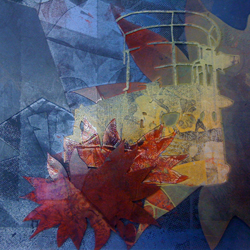
Monumental Monotype Strategies
Frol Boundin, New Mexico State University
[I3-J3-K3] Saturday May 21, 10:00am-3:30pm, Printshop, AA241C
Participants:
Frol Boundin, The University of South Carolina, Assistant Professor
Tim Van Ginkel, University of New Mexico, Assistant Professor
Mary Robinson, University of South Carolina, Associate Professor
William Howard, Western Illinois University, Professor
Kristin Calhoun, University of New Mexico, Graduate Student
Aaron Ishaeik, MJE San Diego, Senior Art Director
This all-day workshop will showcase a collaborative approach to the creation of large scale monotypes. Utilizing multiple handmade and digitally produced plates, and working on a large etching press, participants will create a series of unique large format prints that exhibit a variety of monotype techniques while formally sharing a basic visual structure. For this event, the participating artists from across the United States will reflect on the metaphor of a printmaking community as a “Sphere” by working collaboratively to design and produce a complex set of large, interlocking etched metal matrices. Each individual artist will also produce a set of additional smaller matrices using a variety of methods, including laser cut styrene plates, shaped aluminum photo plates, sintra board, pronto plates, and collagraphs to use in combination with the master matrix. During the workshop, each artist will showcase a personal approach to the printing of the master matrix with the addition of their individual plates. A variety of inking strategies will be explored, including viscosity, trace monotype, split fountain rolls, stenciling, stamping, and more. This will also be an interactive event; utilizing both subtractive and additive inking methods, we will invite the conference attendees to create prints using our multitude of matrices, contributing to the large volume of thematically connected works.
______________________________________________________________________
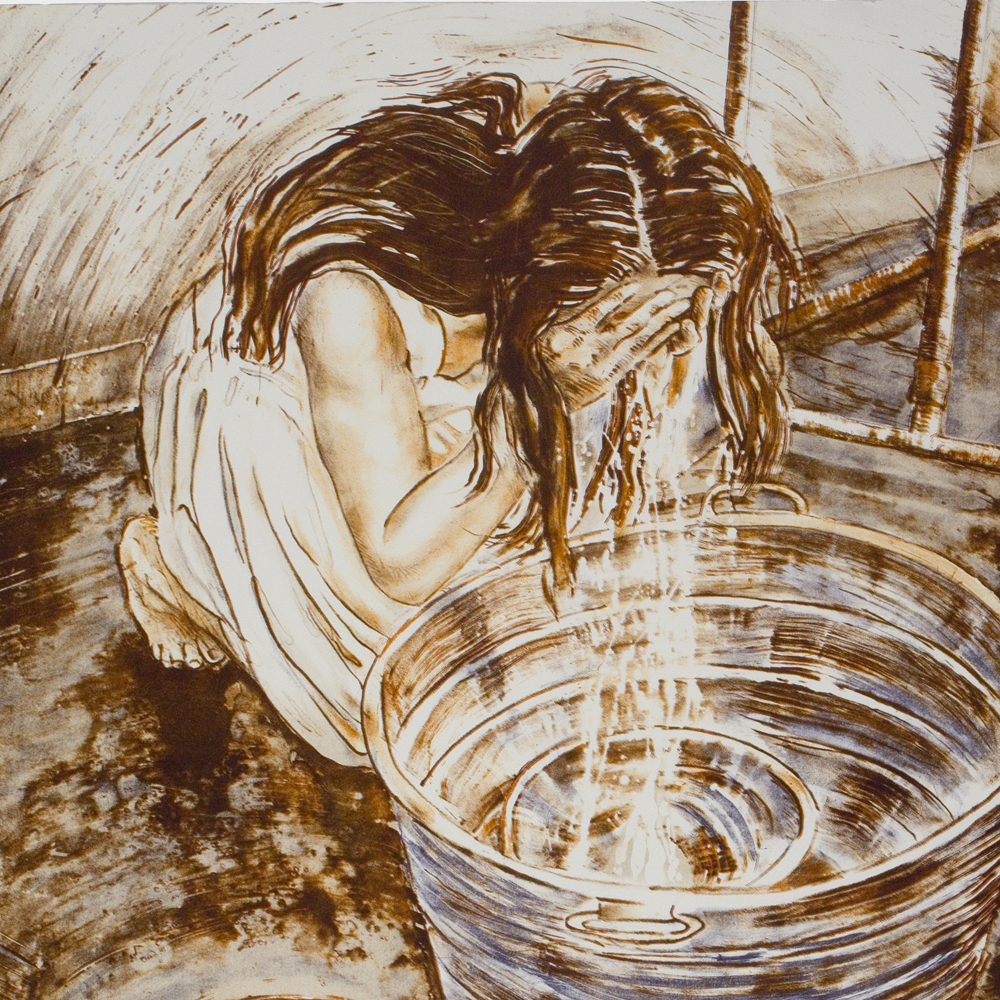
Record of a Collaboration
Ruth Weisberg, University of Southern California and Andy Rubin, University of Wisconsin – Madison
[J1] Saturday March 21, 12:00-1:30pm, Printshop, AA 241 West
Ruth Weisberg and Andy Rubin will present materials from their lithographic collaboration completed in the UT Printmaking Studios during the week prior to the conference. Their demonstration will present some of the methods they used for their print, and some of the color proofs from the project.
______________________________________________________________________
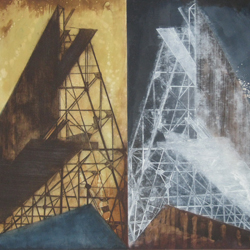
Innovative, Non-toxic Cardboard Drypoint Plates
Jenny Robinson, San Francisco, CA
[J2] Saturday March 21, 12:00-1:30pm, Printshop, AA 241 East
I have developed a method of making cheap, non-toxic, easy to execute, cardboard dry point plates. These plates have enabled me, and my students, to make large scale (60” x 40”) dry points from a substrate that is easy to work and without the weight and wastefulness of using huge sheets of copper or zinc for a relatively small editions. I would demonstrate how to make these plates from scratch, show the huge variety of mark making and tonal variations possible and print a demonstration plate.
